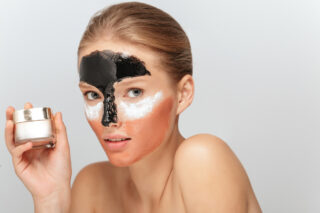
More Beauty Skin Care & Gorgeous Smiles Articles
Do You Know What’s In Your Beauty Products?

Healthy Beauty
Spring is in the air and people of all ages and genders are prepping for summertime unveiling. To get ready, some people are putting in major work to shed pounds and shape up their body, others are drinking all sorts of potions and concoctions, and many are relying on cosmetics and personal care products of all kinds to do the job. Thus, it is safe to say that beauty is big business offering all types of products to give people the needed help. In the business of beauty there may be products out there that can be considered unsafe because of the types of ingredients used to increase the yield of the product for mass production and increase of shelf life. This being said, in purchasing personal care products, focus must be on paying attention to labels, ingredients, and what is potentially absorbing into the body by fully researching products. However, there is an upsurge of natural products that may be able to deliver similar or better results without any negative health concerns.
The question is what ingredients to look for on packaging. First and foremost, look for products that do not contain a laundry list of chemicals you cannot pronounce. I have noticed that some companies will use the Latin name of some herbs to protect their product from being duplicated. Here is a list of chemicals that may deliver more than gorgeous hair and pretty skin but may potentially deliver irritating chemicals that can cause toxicity and more work for your body to do to keep it safe and healthy.
Briefly, personal care products known as cosmetics are created from mixtures of chemical that can be natural or synthetic. These mixtures have various purposes: There are those that are designed for skin care to cleanse and/or protect the skin. Other cosmetics are designed to enhance or alter one’s appearance (there are a ton of mind-blowing feature altering makeup videos on social media), to conceal blemishes, to enhance the natural features, and to perfume the body.
To be self-responsible for your own health it is reasonable to have some knowledge about what you are exposing yourself to. Let’s take a look at where the problem lies in cosmetics that takes being aware of. There are some manufacturers that may not consider certain chemicals dangerous and will include these toxic chemicals as ingredients in the makeup and hygiene products.
Here is a list of ingredients found in personal care products (shampoo, toothpaste, hair conditioner, face creams) and cosmetics that are potentially dangerous:
- Alcohol
- BHA and BHT
- Ethoxycinnmate
- Benzophenone
- Homosalate
- Oxybenzone
- Coal Tar Dyes
- DEA, MEA, and TEA
- P-phenylenediamine
- Diethanolamine
- Formaldehyde
- Synthetic fragrances
- Hydroquinone
- Lead
- Parabens
- Petrolatum
- Phthalates
- Polyethylene Glycol
- Siloxanes
- Sodium Laureth Sulfate
- Toluene
- Triclosan
Here is a list of common reactions and symptoms to the chemicals in personal care products and cosmetics that a person may experience:
- Potential disruption of the skin renewal processes
- May be endocrine disruptors and acne breakouts
- May be toxic to the brain leading to various types of cancer and cause headaches
- Chemicals can combine to form nitrosamines, which are harmful and Carcinogenic
- Respiratory irritation and suffocation
- Dizziness, drowsiness, and fatigue
- Skin allergies and dermatitis
- Irritations in the reproductive system and with the male reproductive system
- May trigger allergies and cause asthma flare-ups
- Human central nervous system disruption
- Nausea and gut inflammation
- Cancers and tumor growth in mammals
- Leading to sensitivity to bacterial infections
In summary, read products labels before you purchase a particular product you would like to have. If the product has any of these chemicals listed above, even if the product is so-called natural, switch to another product that has seven or fewer ingredients that you can recognize. It is reasonable to know that preservatives are used to extend the shelf life of products. Therefore, with natural products that do not have preservatives expect to pay more and the product to have a shorter shelf life. Look for natural products that are potent so that the product will deliver its benefits well before it expires. Do your research online and look for products with full disclosure so you can make an informed decision about what you put on your body. Practice safe beauty!
Other Articles You May Find of Interest...
- Plastic Surgery Without Anesthesia?
- The Top Benefits of Dermal Fillers for Rejuvenated Skin
- When To Start Botox? Here’s What Dermatologists Recommend
- What Safety Measures Should Be Taken Before Abdominoplasty Procedures in Sydney?
- 6 Benefits of Regular Exfoliation for Maintaining Clean and Healthy Skin
- Staying Healthy and Beautiful After 50: The Complete Guide for Women
- Summer Hair Care Tips: Keeping Your Hair Healthy and Hydrated

















